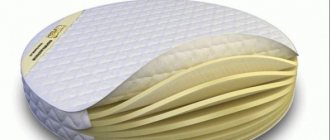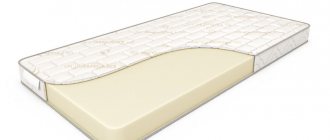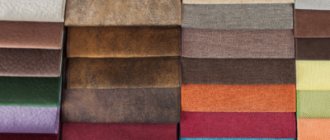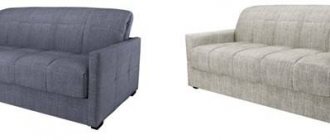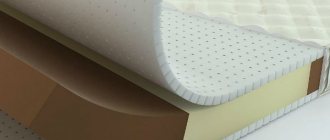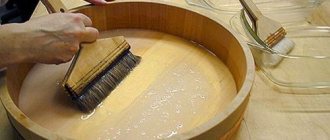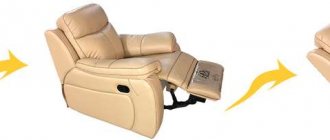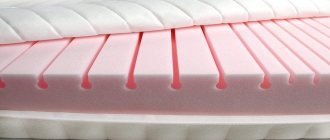Types by density
The higher its density, the longer the service life will be. By the letter indicators that appear on the label, you can navigate the types of foam rubber. Digital values indicate density indicators (the very first digit), subsequent ones indicate compression stress indicators.
Soft
Foam rubber is suitable for equipping sleeping places (sofas, beds, couches). Its approximate density is from 25 to 45 kg per 1 m3. Good indicators of softness, elasticity, and firmness provide comfort during sleep. There is no feeling of discomfort from sitting or staying in one position for a long time on such a sofa; you can relax in your sleeping place.
Soft material is designated with HS symbols. This marking is affixed to the packaging.
Attention The product is quite pleasant to the touch, but not durable. You have to constantly repair or completely change the entire canvas.
Standard
Manufactured from a base polyol. It may include additional components to obtain the required strength, density and elasticity. Most often, this type of foam rubber is used for finishing armrests and headrests in upholstered furniture. Density - 25–30 kg per 1 m3.
Tip To choose a standard foam rubber, you need to find the ST marking on the label, but also focus on the numerical values. They are indicated to show the buyer the density and compression stress.
The standard version is the most common on the market and can be used for restoration or self-assembly. The only and significant disadvantage is its low strength: foam rubber cannot withstand heavy loads. You cannot operate it with increased loads (it will not withstand more than 90 kg).
Hard
Not suitable for filling children's beds. This is a rather unpleasant option for relaxation. But it’s great for people who prefer hard surfaces to soft ones. Density - from 25 to 40 kg per 1m3. Marking: HL mark.
Ideal for sofas that are constantly used for sleeping. It is best to sleep on it rather than use it as a resting place for everyone.
Increased rigidity
Special polyols give increased rigidity to the product. They increase strength many times over, but this indicator depends on the components included in it. Density - 30 kg per 1 m3. An excellent material for making mattresses and sofa coverings. With a higher density value, the furniture can withstand increased loads. Marking - EL.
There is no weight limit. This is a comfortable option for a sound and long sleep. If you put another additional layer of foam rubber on top with increased comfort, the surface will become softer and more comfortable for sleeping in any position.
Highly elastic
It has a density of more than 30 kg per 1 m3 and can withstand a weight of 100 kg. Most often it is used to produce high-quality mattresses. The material has amazing load-bearing capacity and initial rigidity. High elasticity is marked on the packaging with the HR sign.
Advice: An exclusive option, quite expensive. These models are used for the production of luxury furniture, like the highest quality canvases listed.
Highly elastic with increased comfort
Comfortable furniture is made of foam rubber with a density of 30–55 kg per 1 m3. This is a soft material. You can relax, sleep, and sit comfortably on it. To select a highly elastic product with increased comfort, you need to find a label with the HR marking with an asterisk.
Highly elastic foam rubber with increased comfort is classified as one of the highest quality materials. It is chosen for luxury premises, where other options simply will not look good against the backdrop of luxury and wealth. Sleeping on such beds is simply unearthly bliss. The same goes for quality.
Attention Foam rubber with such characteristics is not afraid of the most severe loads, it can be used around the clock and always lives up to expectations.
How to make a sleep product yourself
To get a high-quality and comfortable foam mattress, you don’t have to go to the store to buy it. You can easily make a homemade sleep accessory using affordable supplies.
You will probably be interested in learning how to make a blanket from pompoms with your own hands.
- Material for making a cover.
- Foam rubber (its thickness and density will directly depend on the desired result).
- Sewing machine.
- Needles, threads and scissors.
If the question arises of how to make a foam mattress, then you need to proceed according to the following scheme:
- First, the marking of the future product is done on foam rubber material.
- Next, a pattern is made for sewing the cover on the fabric. In this case, you will need to provide a few centimeters for the seam allowance.
- The cover is sewn together using a sewing machine, after which it can be put on a foam blank. To ensure that the filler can be cleaned at any time, it is worthwhile to include a zipper in the case.
- The main purpose of the fabric cover is to protect the foam filling from various external influences - moisture, wear and contamination. But in order for the result to also be an attractive sleeping product, you should choose covering material that has a stylish and bright color.
As a result of these simple steps, you will get a very comfortable and durable foam mattress. You can also use coconut as a filler for your DIY accessory, which will have a more beneficial effect on the spine.
Next SofasCanape furniture: what is it
Thickness
The thickness of foam mattresses can start from 7 cm and reach up to 30. We do not recommend using mattresses below 10-14 cm as an independent sleeping place for an adult.
A mattress with a foam thickness of 10 cm or more is an excellent and affordable alternative to models made from other materials. For its manufacture, the manufacturer usually chooses high-density polyurethane foam, which guarantees:
- correct distribution of the load on the body,
- rapid return of the material to its original state, regardless of the strength and duration of the load,
- adjustment to the anatomical features of the owner.
What is polyurethane foam filler on a sofa?
PPU material is superior to rubber and caoutchouc in its characteristics. High density allows you to obtain high-quality products from polyurethane foam. For furniture, polyurethane foam with an index of at least 30 km/m3 is used. Materials with a lower value are used only for making pillows.
This “filling” is characterized by the absence of wire blocks. The entire space inside is occupied by polyurethane foam (abbreviated as PPU). The material is a subtype of foam rubber. When making some models, contour cutting is used, which provides an attractive design along with comfort.
Polyurethane foam is produced by artificial gas filling of polyurethanes. Advantages of PPU filler:
- the composition does not include allergens, which later become a breeding ground for microorganisms;
- the material is made from environmentally friendly substances;
- allows air to pass through;
- quickly restores shape after deformation;
- availability;
- used in various furniture products. Disadvantages of PU foam filler:
- poor resistance to sunlight;
- flammable;
- highly elastic;
- does not withstand heavy loads.
Furniture with polyurethane foam filling is practical and durable.
Important! Often problems with the spine and restless sleep are associated with the place where a person sleeps. That is why it is important to choose the right furniture
Varieties of ppu
Depending on the source raw material, polyurethane foam has the following classification:
- Hard. Used for thermal insulation, sound insulation, and construction.
- Elastic. Household filters, sponges, and gaskets are made from it.
- Self-foaming. Included in polyurethane foam and adhesive joints. With the help of such materials, voids are filled and insulation is carried out.
Based on the type of sofa filling, PU foam is divided into two types:
- Blocky. This form is produced by the supplier in the form of a large block. At furniture factories it is cut into layers of the required size. The result is a part of the sofa made from sheets of different densities. Molded polyurethane foam. Produced by pouring hot liquid into prepared molds.
- During a chemical reaction, the filler takes on a given shape under pressure. The result is blocks of the specified sizes. The advantage of such production is the absence of waste after processing. Sheet polyurethane foam. It consists of thin sheets that cover the blocks during the production process and provide softness to the seat. Used to treat sofas before upholstery.
- PPU crumb. During the production of blocks and sheets, crumbs are waste. This type is used for stuffing decorative pillows.
Attention! The cast type is more expensive due to the long production process. There are a number of soft paddings that are used together with others to give furniture softness or rigidity, as well as improve other characteristics.
They can often be found filling armrests and backrests, as well as decorative pillows.
There are a number of soft paddings that are used together with others to give furniture softness or hardness, as well as improve other characteristics. They can often be found filling armrests and backrests, as well as filling decorative pillows.
- Sintepon. The structure contains straight fibers and is very light.
- Holofiber. As a result of treatment with silicone, elastic balls are obtained, which have the advantage of quickly regaining their shape.
- Synthetic fluff. Widely used to replace natural down. Lightweight and voluminous material, resistant to deformation.
Advantages and disadvantages
Each type of sofa has its own requirements for choosing filling. Usually, for use as a sleeping place, a material is selected that can maintain elasticity and density for a long time. In addition, it must be hypoallergenic and provide anatomically correct support for the body during sleep or rest.
Spring blocks
Spring blocks used as fillers for sofas can have different types of construction. The classic version is the one in which the springs form a single unit and are connected by a common frame. This base does not have an orthopedic effect and can withstand weights of up to 100 kg, but it is cheap and retains its original shape for quite a long time.
Sofa bases in which the springs are connected into an independent unit are more suitable for sleeping. They belong to the orthopedic category, withstand much greater loads, and deformation is absorbed pointwise, locally. There is another type of spring blocks. It is called a “snake”, based on the way the elements are connected, and is considered the most durable. In terms of the intensity of withstanding loads and cost, this option is one of the best.
Among the obvious advantages of sofas with spring blocks are the following.
- Significant service life. Metal springs can withstand at least 10 years of operation without losing their original consumer qualities.
- Ability to withstand the most intense loads. Depending on the type of spring block used, this figure can vary from 120 to 150 kg. This option is suitable for larger people who are uncomfortable with less rigid, sagging fillings.
- Optimal ratio of cost and quality. All parameters of the filler in the form of spring blocks fully correspond to the declared price level.
There are also disadvantages. Not all spring blocks have an orthopedic effect; in addition, even they become noticeably deformed over time and lose their former elasticity. The spring filler has the lowest repairability; to extend its service life, the use of additional softening cushions made of foam rubber and silicone is required. Under excessive loads, the metal spiral elements can break, breaking through the expensive packing.
Polyurethane foam
PPU or polyurethane foam has the popular name “foam rubber”; it is often used as stuffing for sofas. Unlike softer materials, it has a fairly high density, holds its shape well, and quickly restores it after contact with the human body. All types of materials, combined under the term polyurethane foam, can be divided into 3 main groups.
- Polyurethane foam in sheets is the same foam rubber that is produced in large plates of different thicknesses. Subsequently, it is cut into individual elements of the desired shape and size. This is the most budget-friendly type of polyurethane foam, not characterized by high density; the maximum load on the material is limited to a weight of 100 kg.
- Molded polyurethane foam is much stronger and more durable. It is manufactured in the form of ready-made molded products, provides good support, and successfully resists deformation loads. In terms of quality, this filler is one of the best. The weight it can support reaches 130 kg.
- The latex version is similar to it, the most comfortable to use, it has impressive consumer properties, takes the shape of the curves of the human body, and easily restores its previous volumes.
All PU foam-based mattresses are hypoallergenic and injury-proof. Their obvious advantages also include the following points.
- Eco-safety. PU foam is used as a filler in children's sofas and other types of furniture that experience medium and high loads.
- Optimal balance of hardness and softness. The material is as comfortable as possible to use, it is pleasant and comfortable to lie on.
- Resistant to absorption of odors and dirt. This filler is especially good for homes where there are small children and pets who are actively exploring the space around them.
- Significantly lower cost compared to a spring block. This filler helps compensate for the inconvenience of a spring block and makes it possible to purchase a modern sofa at a reasonable price.
- The material does not accumulate dust inside, and mold does not grow in it due to dampness if moisture has leaked inside.
How does it work
Filler – polyurethane foam for orthopedic mattresses and upholstered furniture
Before choosing a sofa, let’s find out what polyurethane foam is. This is a synthetic porous substance consisting of cells filled with air. During its manufacture, the liquid composition foams and then hardens. Polyurethane foam consists of 90% air and has thermal insulation properties. PPU is the same foam rubber, it is used almost everywhere - as a filler for furniture, toys for children, sponges for dishes, washcloths and much more are made from it.
Foam rubber sheet to give softness to products
It is widely used as a filler due to its compactness; this property gives softness and elasticity to the product. It is produced in the form of small sheets - this is foam rubber, and also in the form of quite strong and massive slabs - this is polyurethane foam. If the material is of poor quality, it will quickly become unusable and begin to crumble. Then it needs to be replaced.
Advantages and disadvantages
Elastic polyurethane foam is used in the furniture and automotive industries
Polyurethane foam has pros and cons. Let's look at the positive properties.
- The main quality is that dust does not accumulate in it, it is completely hypoallergenic. This ability is important for those who are prone to allergies.
- During production, it is treated with an antibacterial and antifungal agent, so it does not cause harm to health.
- Can last a long time and is wear-resistant.
- Has good breathability.
- Thanks to its elasticity, it instantly restores its original shape.
Imprint of hand shape after pressing on viscoelastic polyurethane foam
There are also negative properties
- Often you come across poor quality polyurethane foam - it will quickly lose its original shape, and the furniture will quickly sag.
- The material does not tolerate direct sunlight and begins to deform. During production, upholstery made of light-protecting materials is used.
- Polyurethane foam is a flammable substance and releases toxic substances when burned.
- For many, the high density of PU foam may seem hard.
- Excessive softness of the material can cause back problems, and in children - curvature of the spine, so it is better for them to sleep on a hard surface.
Polyurethane foam or spring block? Which sofa filling is “best”?
Upholstered furniture based on an independent spring block
Enough time has passed since spring blocks were replaced by materials that are used as filler for upholstered furniture - latex, holofiber, polyurethane foam, padding polyester. But what is better - a spring block or polyurethane foam?
Currently reading: Combination of curtains and wallpaper in the interior: Top photos, tips, videos
Filling the accordion sofa on a metal frame
| Comfort | This property is important for any furniture, no matter what function it performs. It is important when you lie down that pits do not appear, then there is definitely no time for rest, but instead of a restful sleep you will look for a comfortable position. The load must be distributed equally over the entire base. What can you say about PPU? It holds its shape well, has excellent elasticity, and adapts to the contour of the human body. Withstands a lot of weight and instantly takes on its original appearance. If the material is of sufficient quality, it will serve for a long time. |
| Spring blocks | There are dependent and independent. In the first version, the springs are intertwined and have long gone out of use. It is simply unbearable to lie on such a foundation; if you press on one spring, it will pull all the others. The second option allows you to have a great rest; in such blocks, each individual spring is packed in a bag, the load in this case is distributed evenly. |
| Thoroughness. | Undoubtedly, polyurethane foam is a durable material. It does not accumulate dust, has excellent breathability, and is harmless. Furniture with such filling will last for many years if used for its intended purpose. But if you often jump on such a sofa, which children especially love to do, then it will quickly lose its elasticity. The same applies to spring blocks; not all can withstand such loads, especially the inexpensive option. Economy class furniture will creak and springs will come out through the upholstery. In high quality sofas, a sufficient number of intermediate layers are placed between the spring block and the upholstery material, so the springs always remain in place. |
| Price. | Furniture with spring blocks is more expensive than with polyurethane foam. But it all depends on the quality of the material. Therefore, think carefully before you buy a cheaper sofa, otherwise the joy of the purchase will turn into big problems. Be sure to ask the seller what kind of filler is inside and what quality it is. After all, it depends on how long the furniture can serve you, whether it will be comfortable, comfortable to sit on or sleep on, so that the original appearance remains the same for as long as possible. |
No one will answer the question “What is better?” Each filler has advantages and disadvantages. It's up to you to decide what you prefer.
Features of quality material
In this case, the service life of the sofa will be long, the furniture will be able to withstand increased loads
In the first place is the density of sofa foam; it should have an indicator of 22 kg/m3. In this case, the service life of the sofa will be long, the furniture will be able to withstand increased loads.
The second important indicator of quality is the thickness of the foam rubber for padding the sofa; it should be at least 4 cm.
Manufacturers who neglect standards, the quality of furniture is low, so its service life is significantly reduced.
Expensive upholstered furniture is made from highly elastic foam filling. This type of polyurethane foam has a multi-stage “layer cake” structure. In the classic version, it consists of a thin top sheet of low density and a lower layer, which is more elastic. The upper flooring has a high level of comfort, and the lower one provides reliable support. Such foam rubber for sofas is expensive; it is in demand in furniture production, as it guarantees high quality products.
Meanwhile, the comfort of a sleeping place does not always depend on density or softness. The orthopedic effect is more pronounced when the foam sheets are moderately resilient and elastic
Sofa foam with a density of at least 30 kg/m3 has orthopedic properties. For the backrest, filler of 25-30 kg/m3 is mainly used. This density has a load limit of 60-80 kg. For higher rates there are no restrictions on the pressure generated.
Sheet and roll foam rubber differ in softness and hardness. Products are:
- Soft - this type of filler can be used in furniture only in combination with a dense foam base. This is the most plastic polyurethane foam (PPU), giving increased comfort to finished products. But it should be remembered that when using the material independently, the load created cannot exceed 60 kg.
- Hard - hard, capable of withstanding loads of up to 100 kg.
- Increased hardness - highly rigid polyurethane foam can withstand a weight of over 100 kg.
- Elastic with increased comfort - this type of foam is better suited for upholstered furniture intended for sleeping. You can rest comfortably on such a surface.
- Elastic with an orthopedic effect - the products are characterized by healing properties, as they reduce the load on all parts of the body.
Rules for the use and combination of materials
When making furniture, types of foam rubber are combined. One product can combine dense and soft polyurethane foam with different comfort levels. Before choosing furniture foam rubber, you should take into account the purpose and operating conditions of the products:
- Sofa-sofa and sofa-book. Sleeping place - ST3542/EL2842, backrest - EL2540.
- The decorative headboard of the soft bed is EL2240, the remaining elements are EL2842/ST3542.
- Corner sofa. Backrest - ST3542, berth - EL2842/ST3542.
- Armchairs, chairs - EL2842/ST3542.
- Kitchen corner - EL2842/ST3542.
- Mattress - EL2842/ST3542 + coconut coir + felt layer.
The main stages of reupholstering leather furniture, expert advice
Foam rubber is used not only for making furniture, but also for its restoration. Polyurethane foam goes well with padding polyester. The latter prevents the filler from sticking to the fabric, smoothes out minor irregularities on its surface, making the furniture even more comfortable and convenient, extending its service life.
To make soft, elastic poufs and seats, foam rubber with latex is used.
Brands of furniture foam rubber
Modern production uses the following grades of polyurethane foam:
- ST is a standard raw material containing a polymer such as polyol (polyesters). The rigidity of products is achieved by selecting the ratio of the components of the main composition. The result is sheets that differ in characteristics. Basically, at least 2 types of polyol are used.
- EL - increased rigidity.
- HL - hard, consist of different types of polyol.
- HS - soft and super soft. Special polyester is used in production instead of ST or in addition to it.
- HR - high elasticity. The composition contains only polyols in 2 or 3 combinations.
- Special - non-flammable, viscoelastic.
The first brand's recipe includes special melamine powder, PHD polyols from Bayer, and flame retardants as additives. Melamine provides fire resistance, but at the same time it negatively affects the properties of furniture foam rubber. Viscoelastic grades contain polyesters and isocyanates.
The most common brands of furniture filler are:
- HS2520 - monolithic amplifier is used on the back of a sofa with a load of 80 kg;
- HS3030 - maximum weight 100 kg;
- HS3530 is the best foam rubber for upholstered furniture; backrests with a load of 100 kg and seats with a load of 80 kg are made from it.
Foam rubber is marked according to 3 indicators: type, density and hardness. For example, brand EL2540 is a rigid sheet with a density of 25 kg/m3 and a hardness of up to 3.2 kPa.
HR
EL
H.S.
Special
H.L.
ST
HS3030
HS3530
HS2520
Tips and tricks for use
Foam rubber for a sofa, mattress or other products will retain its qualities longer if you adhere to certain rules:
- store furniture foam rubber in a place protected from sunlight;
- Turn the foam mattress over periodically, once or twice a month;
- use and store foam rubber products away from sources of fire;
- avoid excessive wetting of foam rubber products;
- choose the thickness of the bed correctly.
We recommend:
- Magic corner for the kitchen: main types…
- Furniture panel, features, advantages and main dimensions
- Foam rubber for furniture: which one is best to use?
- Varnish for a wooden tabletop: rules for choosing and…
- Thread curtains: types and features, ideas for...
- Stained glass in a modern interior, new technologies and…
Related posts:
- Foam rubber for furniture: which one is best to use?
- How to reupholster a sofa with your own hands: step-by-step instructions with photos
- Stretch ceilings: photo for the hall, two-level options in the interior of the room
- How to decorate an empty wall in a room
- Bright room: choice of colors and furniture, photos of interior examples
- Design of a small apartment: interior solutions and ideas for modern renovations with photos
- Apartment interiors in a modern style: beautiful renovation design, real photos
- How to make a sofa with your own hands (+photos, diagrams)
Upholstery materials
Textile
When choosing fabric, you need to pay attention to practicality, not beauty. You should not opt for synthetic materials that do not last long.
You also need to focus on the colors. The pattern depends on preferences and the existing interior of the room where the sofa will be located.
There are several points to consider when choosing fabric for upholstery with your own hands:
- The fabric material should smell good and not fade. A bad smell indicates the use of low-quality dye.
- Textiles can be with thick pile or thin pile. Depending on the choice, the color will be formed. The transition to dark or light can be varied by combining different piles. At the same time, when cutting, you need to take into account the direction of the pile if the upholstery is made independently. When purchasing ready-made material, you need to take this into account too.
- To reduce losses when reupholstering sofas, it is best to take fabric with a small pattern. You can use plain ones. To diversify the design, you can choose textiles with large prints (geometry, flowers). But then all the lines and shapes must be located in the same direction, similar to the stated sketch.
Foam rubber
To cover a sofa, you need a foam rubber mat with a thickness of 40 mm and a density of 30 kg/m³ (for the seat and back), and for armrests and sides - from 25 kg/m³. Foam rubber has different properties. Marking of foam rubber depending on characteristics:
- ST – standard;
- EL – extra hard;
- HS – increased softness of the material;
- L – hard;
- HR is a latex material with enhanced orthopedic properties.
Advice On the market of foam rubber materials you can find foam rubber that remembers the shape of the body. This is a very comfortable material, practical, it is good for upholstering a sleeping place. It is better to use a thick canvas-type fabric as a backing.
When choosing foam rubber, pay attention to its strength. It should not stretch or tear
The structure is only integral in order to ensure the appropriate appearance after cladding.
The smell of foam rubber should be pleasant and not give off caustic or bad-smelling substances. If there is a smell, then this indicates the use of cheap raw materials in the production of the material.
To check the quality of foam rubber, you need to do a standard test. You need to clench the foam rubber in your fist and quickly release it. When it slowly returns to its original shape, we can talk about the good quality of the material.
Good quality foam rubber consists of many small bubbles. If large cavities are visible to the naked eye, then the foam rubber is of low quality and it is not recommended to use it for covering a sofa.
here
Leather
Sofas, which themselves are made of leather materials, are covered with leather. Eco-leather is recommended as an upholstery material, not natural leather. For a standard size sofa you need to take it with a certain margin, as the leather tightens
Before choosing the right leather fabric, it is important to take into account the design features of the furniture:
- If the sofa has a complex structure, it will be difficult to disassemble it into its component parts and cover it with high-quality leather. In such a situation, you will need to try to correctly distribute the upholstery material so that it accurately follows the shape and style of the furniture.
- If the model is angular, then the skin is pulled as tightly as possible over the joints and corners of the frame.
Old furniture must be restored before upholstery. Both the upholstery and the soft filling are replaced. In special cases, replacement of rigid parts of the frame is required (how to change springs and slats?). A successful choice of material is a choice:
- leatherette;
- eco leather;
- vinyl leather.
The choice depends on financial capabilities, preferences, and the required color.
Important When upholstering a sofa with leather, evaluate the condition of the legs or wheels of the product. If you don't put them in order, their appearance will suffer greatly.
The legs can be sheathed with the same material, but less cheap.
Tips for choosing
Before you purchase furniture foam rubber, you must learn to read the labeling. You should not try to save on the quality of the filler, as this will affect the functionality, aesthetics, and durability of the finished structure. When choosing a material, you need to consider a number of recommendations:
- the minimum thickness of sheets must be at least 3 cm, the density of foam rubber for furniture is from 25 kg/m3;
- if the filler is purchased in a store, you need to check whether it holds its shape well using simple tests (squeezing, bending, tactile sensations);
- the composition should be studied, especially if polyurethane foam is chosen for children's furniture (some manufacturers add substances that can cause allergies).
The correct name for the material in question is soft polyurethane foam. In Russia, the name foam rubber is common for the reason that several decades ago the main supplier of raw materials was the Porolon company (Norway). Over time, its name became a household name and firmly established itself in the countries of the former USSR.
Polyurethane foam is the most popular and common filler for upholstered furniture. It has significant advantages, against which the disadvantages do not seem so significant. The material is available in a wide range, so you can choose it for the manufacture of different pieces of furniture.
It is important to pay attention to the markings; all information about the material is indicated there.
Why you should choose foam rubber for a sofa
Foam rubber has many positive features, such as:
- able to not produce dust or become moldy;
- is a hypoallergenic material;
- retains its shape well during use;
- under the influence of high temperatures its elasticity remains the same.
You can use foam rubber whole or only its pieces, which can be preserved from the production of higher quality furniture. It is better to use solid material as the stuffing of the sofa, since previously used pieces may become unusable sooner. In order for the furniture to last longer, foam rubber can be combined with other fillers, such as a spring block.
If furniture is used frequently, such filler may lose its properties due to heavy load and the furniture will look worn out. In order to return it to its former convenience and comfortable use, it needs to be replaced. This filler is distinguished by hardness, elasticity and density. The density of foam rubber affects its service life and, accordingly, its quality. In order to determine the level of rigidity of the material, it must be squeezed tightly.
In the furniture industry, standard foam rubber (ST) and increased rigidity (EL) are often used. The standard one has a density of 25 kg/m3 and its rigidity is comfortable. In order to determine the density and hardness of a material, you need to look at its brand, for example ST3542, where the first two digits indicate its density, and the last two indicate its hardness index. This material will last at least 10 years.
For furniture with expected loads of 90-100 kg. they use foam rubber of increased rigidity, for example brand EL2240, which is the most common today due to its optimal price-quality ratio. It is used as a filler for inexpensive furniture with a service life of no more than 5 years, as well as for children's mattresses.
EL2842 has a longer service life and can be used for up to 10 years. It has greater rigidity and is suitable for sofas, sleepers, office chairs and so on. The density of 30 kg/m3 will allow you to sit or lie on it comfortably and comfortably; it will also allow the material not to sag for a long time.
If you want the furniture to last longer, then the density of the filler should be higher. It is worth noting that the density of the material used for the armrests and backrest may be lower than that for what will fill the seat. For a sofa that will be used as a sleeping place, the thickness of the filling should be at least 4 cm.
The cost of filler, like any other product, depends on its quality. Foam rubber for a sofa can be bought in construction stores, and you can find pieces of it from furniture manufacturers either in their warehouses or in online stores.
Damage to foam mattresses
Are there any health risks from polyurethane foam mattresses? Foam mattresses have been made for decades, and the controversy over their harmfulness will not subside. And there are reasons for these disputes: synthetic “origin” and low orthopedic properties. Reviews of polyurethane foam mattresses can be found here.
The material is made from synthetic components. They emit volatile substances with an unpleasant “chemical” odor.
And some cheap models, manufactured in violation of technology, retain it for a long time, or even the smell does not disappear at all. The substances released are hazardous to health, just like those released when a mattress burns.
But it has not been proven how harmful the released substances are in minimal quantities.
The video shows the density of foam rubber for a mattress:
Harm has not been proven, so polyurethane is the most common material for the production of mattresses.
Its advantages contribute to this:
The harm of foam mattresses also lies in their low orthopedic properties. Doctors insist that the sleeping place should be quite hard.
Therefore, mattresses are equipped with an independent block of springs, a layer of coconut coir and other “devices”. And the usual foam version is often soft, bends greatly, which leads to curvature of the spine.
The body does not always rest well on soft things; in the morning there may be numbness in the limbs, muscle stiffness, and tingling in them
The result, at a minimum, is poor health and bad mood.
And the maximum is problems with the spine.
What is the composition of the Asonia pillow?
How to choose an orthopedic neck pillow?
So which is better?
There is no clear answer to this question, and each user has his own opinion. But I will rely solely on my practical experience in this area and logic. If by default we assume that all fillers are of the same quality, whether spring or polyurethane foam, then I would lean towards the latter, due to its orthopedic qualities. But to do this, you need to make sure that the polyurethane foam is installed on a flexible base and corresponds to the declared density. Knowing the desire of many manufacturers to save money, I would not buy a domestic sofa using polyurethane foam (unless from a VERY well-known factory, and then I would first study reviews from other consumers). I really don’t want to buy furniture, and then regret it six months or a year later and suffer on a sagging and sagging sofa.
It’s still easier with a spring block, but if I were choosing a sofa, I would take the more expensive option with independent “Pocket Spring” springs. It’s worth paying extra for quality, because comfort during sleep and rest depends on it.
I hope that the information I have presented will be useful when choosing a sofa, and in order to continue to be aware of various furniture nuances and secrets, subscribe to my channel, like, and I promise to regularly write new articles on current topics)))
PS Dear subscribers, casual readers and everyone who likes my articles! You can always provide all possible assistance in the development of the channel in order to receive useful tips and interesting materials about furniture and decor even more often. I will say right away (and I insist on this!) that I want all your contributions to be ONLY VOLUNTARY, and given with a PURE HEART. The amount of the transfer is not important to me (even a ruble, even a million), and I will NEVER divide my audience into those who help and those who just read my articles! Whether to help my channel or not is a VERY PERSONAL matter. But just in case, I’ll give you the details:
- WebMoney R735859204814
- Yandex.Money 410015178456653
Quality indicators
To understand the quality of the material with which furniture is filled, it is important to know the main characteristics by which it is determined. These include the following indicators:
- density;
- strength;
- compressive stress
- markings;
- elasticity;
- permanent deformation;
- degree of comfort.
Each of the listed criteria needs to be considered in more detail. As already mentioned, the density of the material determines its purpose. The higher this indicator, the greater the load the material can withstand on furniture and the longer its service life.
The compressive stress of a material indicates how much force must be applied to compress the sample. Rigid varieties of foam rubber are sometimes artificially equipped with strong compression to improve performance, but when the cells with air are opened, the material returns to its structure.
Foam rubber markings have a separate classification, which will be discussed in our article below. The elasticity of the raw material is determined by dropping a special test ball onto it. They throw it onto the material and check the degree of rebound: if the ball bounces high, then the foam is hard and less elastic.
To determine the indicator of residual deformation, the method of strong compression of the sample is used, which is left in this state for a while under the influence of a certain temperature and humidity. At the end of the period, the sample is measured and compared with pre-prepared standard indicators. Hard foam will have little permanent deformation.
Indicators of the degree of comfort are also represented by two designations: support coefficient and comfort coefficient. These criteria are determined by the softness of the material, as well as the distribution of the load along the plane.
